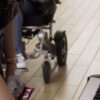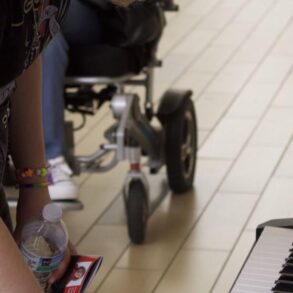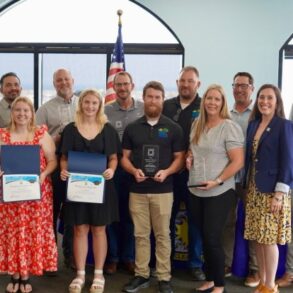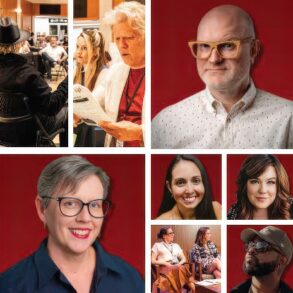Susan Magsamen, co-director of the NeuroArts Blueprint and co-author of “Your Brain on Art: How the Arts Transform Us,” gives the keynote presentation at Who Needs Art: A Thought Leadership Summit 2023. (image by RW Photography)
Since prehistoric times, humans have created art to express themselves, inspire one another, and glorify their gods and goddesses.
In more recent times, humans have harnessed art to improve human health and wellbeing. In an Oct. 16, 2023, article, the “Mayo Clinic Press” reported on the use of creative arts therapy to help treat conditions involving mental health, cancer, stroke and more.
The Mayo article quoted the American Congress of Rehabilitation Medicine as saying that making or even just seeing art can impact the brain by increasing serotonin levels, increasing blood flow to the part of the brain associated with pleasure, fostering new ways of thinking, and helping people imagine a more hopeful future.
KANSAS CITY IS ON THE CUTTING EDGE OF NEUROARTS
Kansas City, long renowned for its artistic prowess, is on the cutting edge of the art/wellness movement. The scientific framework of this movement is known as neuroarts, the study of how the arts and aesthetic experiences measurably change the body, brain and behavior, and how this knowledge is translated into specific practices that advance health and wellbeing.
“Arts and creativity are inherent in who we are, and that became more evident through COVID,” said Dana Knapp, president and CEO of the ArtsKC – Regional Arts Council. “People clung to creative and artistic activity to cope with loneliness and isolation. It gave an opportunity for people to connect. I wanted to focus on how the arts benefit us.”
So Knapp contacted Susan Magsamen, founder and director of the International Arts + Mind Lab, Center for Applied Neuroaesthetics at Johns Hopkins University School of Medicine.
Magsamen is the co-author of “Your Brain on Art: How the Arts Transform Us,” a 2023 New York Times bestseller. In it she wrote that “We know how art, in its countless forms, heals our bodies and minds. We’ve got the evidence for how the arts enhance our lives and build community. We know, too, how the aesthetic experiences that make up every moment alter our basic biology.”
Knapp’s outreach to Magsamen led to Kansas City coming on board as one of the three pilot communities (along with Palm Beach and New York City) to participate in the NeuroArts Blueprint initiative. The initiative arose from five foundational principles:
- Experiencing art is fundamental to being human, a common thread across cultures, racial and ethnic backgrounds, age groups, income levels, and skill sets. The arts offer a shared language, a means of elevating diverse voices, and a catalyst for action.
- The arts, as expressed through many modalities, have demonstrable, evidence-based impacts on physiological and psychological health and wellbeing.
- Science and technology make possible the ability to understand and measure the biological effects of the arts and aesthetic experiences on individuals and populations.
- Neuroarts provides the connective tissue to bring together science, the arts, and technology as equal partners to advance health and wellbeing.
- The benefits of the neuroarts must be readily, consistently, and equitably accessible to all populations across the lifespan in every community around the world.
ArtsKC established the Kansas City Community NeuroArts Coalition and held thought leadership summits on the topic in May 2023 and May of this year.
“We have the ability to be a convener and a connector and a supporter of this work that has been happening for decades,” said Anne Palmer, ArtsKC director of audience development. “We’re able to bring people around the table to have conversations. It is a fundamental responsibility of ours to be aware of what is making the arts relevant today.”
Participants in this year’s thought leadership summit included Theresa Reyes-Cummings, deputy director of the Community Mental Health Fund, an arm of Jackson County Mental Health Services.
“Having a space where a person can creatively express themselves with acceptance and encouragement organically creates a sense of belonging and affirms a humble confidence that can carry throughout an individual’s lifetime, thus improving wellbeing,” Reyes-Cummings said.

THE POWER OF MUSIC
At the Power of Music Laboratory at the University of Kansas Medical Center, researchers use tools and techniques such as neuroimaging to study the physical and psychological impacts of music.
“We work with people who have Alzheimer’s disease, people who are being treated for chronic pain, people who are living with conditions like depression or anxiety,” said Rebecca Lepping, a cognitive neuroscientist and music psychologist who directs the lab.
Lepping is the principal investigator of a study on how music impacts the mood and quality of life of people with dementia.
“We are also working with participants in the KU Alzheimer’s Disease Research Center to explore how a lifetime of music experience might help reduce the risk of developing dementia,” she said.
Lepping said researchers at her lab have demonstrated a connection between music and pain reduction.
“We have done a study with people who have chronic pain/fibromyalgia and shown that there is an objectively lowered pain response when they listen to music that is relaxing,” she said. “It’s not just distracting them from the fact that they’re experiencing pain, it is actually affecting their physiology.”
Lepping also is working on a study of music therapy as a stress intervention tool for pregnant and postpartum women.
“I think it is going to become more integrated into health care wellness as a general concept,” she said.
GROWING ACCEPTANCE
Sharon Freese, chief operating officer of behavioral health at University Health, said the art-wellness connection is meeting growing acceptance.
“So many people in the mental health world are looking for studies and research,” she said. “Though it probably has always been there, we’re getting studies back that say, ‘here’s the actual benefit.’”
Freese said University Health employs expressive art therapists and music art therapists in its behavioral health practice. Her goal is for those therapists to serve in more of a first line of treatment role.
In addition, Freese said she would like to see the arts be utilized as a tool to prevent mental illness.
“When people have outlets through the creative arts, it stabilizes their mental health,” she said. “My hope is that this will be used as a prevention tool down the road.”
THE ARTS-WORKPLACE-ECONOMY CONNECTION
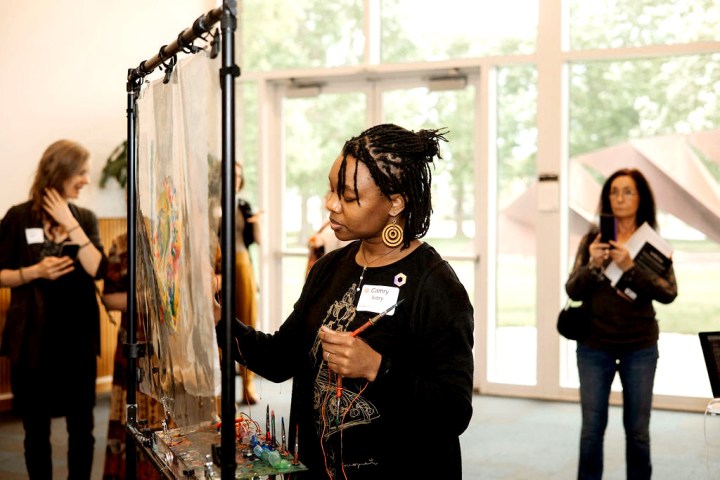
Kansas City “has a unique understanding of the benefits of the arts to our community and economy,” said Megan Crook, director of public policy for the Civic Council of Greater Kansas City, a nonprofit organization composed of the leaders of the area’s largest private employers.
Crook said, “There’s a lot of opportunity for the business community in Kansas City to incorporate some of the work coming out of the neuroarts field and providing that benefit to their employees.”
Supporting art and wellness can benefit businesses in areas such as brand image, creativity, innovation and overall success, Crook said.
Crook said neuroarts in the workplace can generate a wide variety of benefits. “There’s the aesthetic side and there’s work-life balance. There’s real scientific research of how the arts can have positive impacts on employee mental health. I think environments where employers have an opportunity to provide that level of support to employees are going to see economic returns as well.”
This post was originally published on this site be sure to check out more of their content

